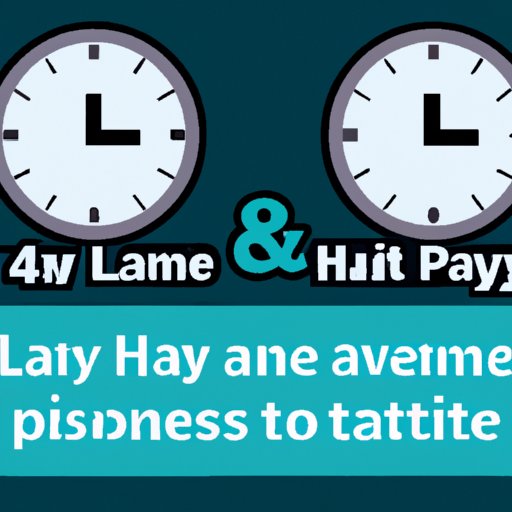Introduction
Time and a half is a form of overtime pay that employers must provide to non-exempt employees who work more than 40 hours in a given week. It is calculated by multiplying an employee’s regular rate of pay by 1.5. Understanding how time and a half works is important for both employers and employees alike, as it ensures that workers are properly compensated for their extra hours and employers remain compliant with labor laws.
Explaining How Time and a Half Works for Non-Exempt Employees
In order to be eligible for time and a half pay, an employee must meet certain criteria. This includes being classified as a “non-exempt” employee, meaning they are not exempt from overtime pay. Additionally, the employee must have worked more than 40 hours in a given week.
Eligibility Requirements
The U.S. Department of Labor’s Fair Labor Standards Act (FLSA) states that non-exempt employees are eligible for overtime pay if they work more than 40 hours in a given workweek. This applies regardless of whether the employee is paid on an hourly or salary basis. In addition, the FLSA requires that overtime pay must be at least one and a half times the employee’s regular rate of pay.
Calculating Regular Hours Worked
When calculating an employee’s regular rate of pay for time and a half purposes, employers must first determine the total number of regular hours worked. To do this, employers should add up all the hours an employee has worked in a given week, then subtract any hours that were not considered part of their regular work schedule, such as vacation days or personal days.
Examples of How to Calculate Overtime Pay
Once an employer has determined the total number of regular hours worked, they can calculate the employee’s overtime pay by multiplying their regular rate of pay by 1.5. For example, if an employee earns $10 per hour and works 45 hours in a given week, their overtime pay would be calculated as follows:
Regular pay: 40 hours x $10 = $400
Overtime pay: 5 hours x $15 (1.5 x $10) = $75
Total pay: $400 + $75 = $475

What You Need to Know About Time and a Half
Different Types of Overtime Pay
It is important to note that there are different types of overtime pay available to employees. In addition to time and a half, some employers may also offer double time, which is calculated by multiplying an employee’s regular rate of pay by two. Double time is typically offered to employees who work more than 12 hours in a single day.
Benefits of Offering Time and a Half
Offering time and a half pay to non-exempt employees can benefit both employers and employees. According to a study by the University of Chicago, employers who offer overtime pay tend to have higher levels of employee engagement and job satisfaction. Additionally, providing overtime pay can help employers attract and retain high-quality employees, as well as increase productivity and performance.
Calculating Time and a Half Pay Rates
Calculating Hourly Pay Rates
Before employers can calculate time and a half pay rates, they must first determine an employee’s regular rate of pay. For hourly employees, this is simply done by dividing their total wages by the number of hours worked. For example, if an employee earns $400 in a given week and works 40 hours, their regular rate of pay would be $10 per hour.
Calculating Time and a Half Pay Rates
Once an employer has determined an employee’s regular rate of pay, they can then calculate their time and a half pay rate. This is done by multiplying the employee’s regular rate of pay by 1.5. Using the example above, the employee’s time and a half pay rate would be $15 per hour ($10 x 1.5).

The Benefits of Offering Time and a Half
Increased Employee Satisfaction
One of the main benefits of offering time and a half pay is that it can help increase employee satisfaction. A study by the University of California found that employees who receive overtime pay tend to have higher job satisfaction and motivation levels than those who do not. This can lead to improved productivity and performance.
Improved Productivity
Another benefit of offering time and a half pay is that it can lead to improved productivity. According to a study by the Society for Human Resource Management, overtime pay can help employers better manage workloads and ensure that projects are completed on time. Additionally, offering overtime pay can help reduce burnout among employees, as it gives them the opportunity to make extra money while still maintaining a healthy work-life balance.
How Employers Can Implement Time and a Half Policies
Developing an Overtime Policy
In order to ensure that employers are compliant with labor laws, it is important to develop an overtime policy. This policy should include information about how overtime pay will be calculated, when it will be paid, and who is eligible for it. Additionally, employers should ensure that their overtime policy is clearly communicated to all employees.
Understanding the Laws Governing Time and a Half Pay
It is also important for employers to understand the laws governing time and a half pay. The Fair Labor Standards Act (FLSA) outlines the requirements that employers must follow when it comes to overtime pay, including minimum wage and overtime pay rates. Additionally, some states have their own laws regarding overtime pay, so employers should check with their state labor department for more information.
Common Misconceptions about Time and a Half Pay
Difference Between Hourly and Salaried Employees
Many people mistakenly believe that only hourly employees are eligible for overtime pay. However, this is not true. According to the FLSA, salaried employees are also eligible for overtime pay if they work more than 40 hours in a given week. For salaried employees, their regular rate of pay is calculated by dividing their annual salary by the number of weeks in a year.
When Does Overtime Begin?
Another common misconception is that overtime begins after an employee has worked 8 hours in a single day. However, this is not always the case. According to the FLSA, overtime begins after an employee has worked 40 hours in a given week. This means that employees who work less than 8 hours in a single day can still accumulate overtime hours throughout the week.
Conclusion
Time and a half is a form of overtime pay that employers must offer to non-exempt employees. Understanding how time and a half works is important for employers, as it ensures that they remain compliant with labor laws and that their employees are properly compensated for their extra hours. Additionally, offering time and a half pay can lead to increased employee satisfaction, improved productivity, and better overall job performance.
Employers should develop an overtime policy that outlines how overtime pay will be calculated, when it will be paid, and who is eligible for it. Additionally, employers should ensure that they are familiar with the laws governing time and a half pay, as well as any applicable state laws. By understanding these regulations and implementing policies that comply with them, employers can ensure that their employees are fairly compensated for their extra hours.

Final Thoughts on Time and a Half Pay
Time and a half pay is an important part of ensuring that non-exempt employees are properly compensated for their extra hours. Understanding how time and a half works, as well as the laws governing it, can help employers create policies that are fair and compliant with labor laws. Additionally, offering time and a half pay can lead to increased employee satisfaction and improved productivity.
(Note: Is this article not meeting your expectations? Do you have knowledge or insights to share? Unlock new opportunities and expand your reach by joining our authors team. Click Registration to join us and share your expertise with our readers.)
